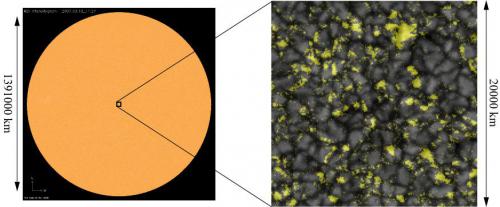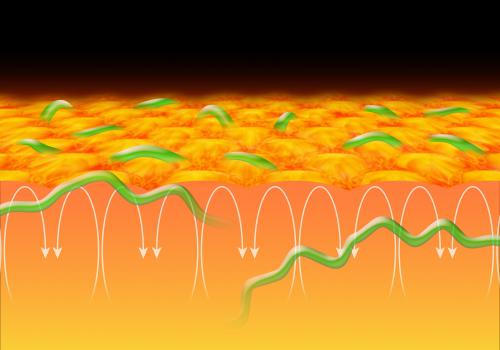A new solar dynamo mechanism discovered by the Hinode satellite
Naional Astronomical Observatory of Japan (NAOJ/NINS)
Japan Aerospace Exploration Agency(JAXA)
National Aeronautics and Space Administration (NASA)
Science and Technology Facilities Council(STFC)
European Space Agency(ESA)
The Sun has strong magnetic fields as represented by sunspots. The mechanism to create such strong magnetic fields is still a mystery, and is one of the most important problems in astronomy. Such magnetic fields on the surface of the Sun are known to drive dynamic activity such as solar flare, and eruptions which in turn can lead to geomagnetic disturbances that can have influence on the Earth and thereby on humans. Studies of the Sun, in particular, of its magnetic fields, are critically important in this respect too.
A research team consisting of Japanese, US, and European scientists have discovered a new type of magnetic field on the Sun with, the solar optical telescope (SOT) aboard the Hinode satellite. These magnetic fields called Transient Horizontal Magnetic Fields (hereafter referred to as THMFs), that have unique properties that are completely different from known properties of sunspots (see Figures A and B):
- Small size: The size of THMFs (1000 km) is 30 to a hundred times smaller than that of a sunspot.
- Short lifetime: While the typical lifetime of a sunspot is from 6 days to a few months, the mean lifetime of THMFs is only about 4 minutes.
- The orientation of THMF magnetic field is horizontal to the solar surface, while sunspot fields are vertical to the surface.
- THMFs are ubiquitous all over the Sun. Sunspots never appear too far from the Sun's equators.
The research team found that THMFs have exactly the same properties both in the quiet sun and in active regions, and the properties are universal all over the Sun. This leads the research team to conclude that THMFs are generated by a new dynamo mechanism in the convective zone below the surface of the Sun. This is called a local dynamo process, since it is driven by small-scale convective motion near the solar surface. The global dynamo responsible for the formation of sunspots is, on the other hand, known to be driven by the global differential rotation of the Sun.
The total magnetic energy flux carried by THMFs is significant, and turns out to be comparable to the energy required to heat the chromosphere and the corona, according to the research team.
This discovery could not have been achieved without the Hinode satellite, with its unprecedented resolving power and unique capability to perform precision measurements of magnetic fields on the Sun.
The total energy of THMFs may be a dominant part of the magnetic energy of the Sun. The research team is continuing to investigate the role of THMFs in the heating of the chromosphere and the corona, and in the acceleration of the solar wind.
Figure A:
Left: full disk image of the Sun. (SOHO(ESA&NASA)) Right: Close up view of the surface of the Sun seen in visible light. The yellow areas show the transient horizontal magnetic fields. (NAOJ/JAXA)
Figure B:
Artist's view of solar convection (granules) and THMFs. The sea-serpent-like magnetic flux tubes (green) are formed by the upward and downward motion of convection. The observed THMFs may be the tops of the sea-serpents residing near the top of the convection zone. (NAOJ)
Regarding the use of images and movies on the page concerned, please visit the page here. The credits of images and movies on this page are “NAOJ/JAXA” unless explicitly stated to the contrary. Regarding images and movies on this page the credits of which are “NAOJ/JAXA”, "NAOJ/JAXA/MSU", or “NAOJ, JAXA, NASA/MSFC”, terms of use for Copyrighted Works owned by NAOJ can be applied. In using the images and movies, the credits should be given.


